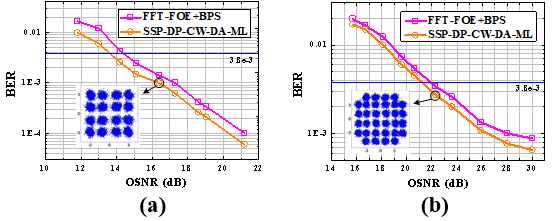Coherent optical communication system combined with high order modulation formats and polarization division multiplexing (PDM) has attracted worldwide research due to its large capacity and high receiving sensitivity. In such systems, signals will suffer from laser-induced severe frequency offset (FO) and phase noise. Therefore, FO estimation (FOE) and carrier phase estimation (CPE) are two essential part of the digital signal processing (DSP) at the receiver side (Rx). On the other hand, parallelization processing is indispensable to reduce the required clock speed in real-time systems. An algorithm with large FOE range, large linewidth tolerance as well as corresponding parallel implementation is challenging to realize so far.
Prof. Songnian Fu and M.S student Jianing Lu, with the Wuhan National Lab for Optoelectronics, Huazhong University of Science and Technology, propose a joint carrier phase and frequency-offset estimation with parallel implementation for dual-polarization coherent receiver. Since the signals from dual polarizations suffer from identical laser phase noise with a constant phase offset, phase information of dual polarizations can be jointly processed to improve the linewidth tolerance of CPE, as shown in Fig. 1. At the same time, the FOE range of our proposed scheme is much larger than traditional FOE. What’s more, we use a novel superscalar parallelization (SSP) structure to realize the parallel implementation of our proposed scheme. This SSP structure can obtain signals from both polarizations. The complex weights of the filters are transferred between adjacent buffers for FO tracking, as shown in Fig. 2. The FOE and CPE performance of proposed scheme is experimentally verified. The proposed scheme also meets the demand of real-time parallel processing.

Fig. 1. Proposed Joint carrier phase and frequency-offset estimation scheme (a) Structure of proposed scheme with phase offset compensation; (b) Schematic diagram of joint algorithm.

Fig. 2. Proposed modified superscalar parallelization structure.

Experimental setup and DSP flow.

Fig. 4. BER performance as a function of OSNR, (a) 10 Gbaud DP-16-QAM, (b) 10 Gbaud DP-32-QAM.

Fig. 5. BER versus FO for different OSNR conditions, (a) 10 Gbaud DP-16-QAM, (b) 10 Gbaud DP-32-QAM.
This paper was published at Optics Express (Vol. 25, No. 5, pp. 5217-5231, 2017) and partially supported by the 863 High Technology Plan (2015AA015502), and National Natural Science Foundation of China (61275069, 61331010).